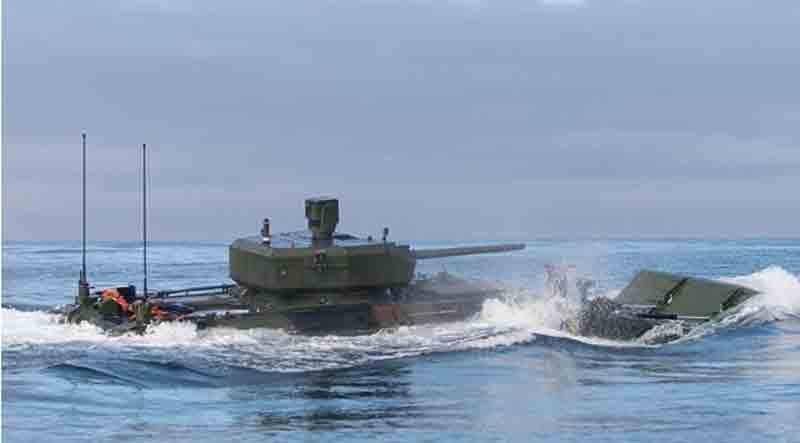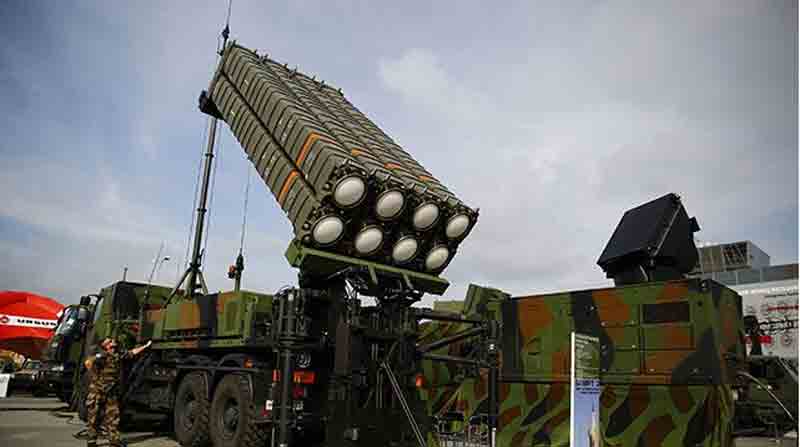On March 14, 2025, BAE Systems Land & Armaments LP, located in Sterling Heights, Michigan, was awarded a contract modification worth $188.4 million by the U.S. Marine Corps to manufacture 30 Amphibious Combat Vehicles (ACVs) outfitted with medium-caliber cannons.
This recent order is part of a larger contract that could reach a total value of $3.85 billion if all options are utilized, as announced by the Department of Defense. It represents a significant advancement in the Marine Corps’ ongoing initiative to enhance its amphibious capabilities.
The production will take place at various BAE Systems facilities across the United States, with funding sourced from the Marine Corps’ fiscal 2025 procurement budget. The project is expected to be completed by February 2028, highlighting the Pentagon’s dedication to improving the Marine Corps’ operational capacity from sea to shore.
This announcement coincides with the Marine Corps’ efforts to adapt its force structure in response to changing global challenges, particularly in contested maritime areas.
The Amphibious Combat Vehicle, developed by BAE Systems in partnership with Italy’s Iveco Defence Vehicles, is a next-generation platform intended to replace the outdated Assault Amphibious Vehicles that have been in service since the 1970s.
This 8×8 wheeled vehicle is designed to transport Marines from naval vessels to land, providing a blend of open-ocean amphibious capability and strong land mobility. BAE Systems states that the ACV can accommodate up to 13 combat-ready Marines along with a crew of three, featuring a design that facilitates a smooth transition from water to land operations.
The variant included in this latest contract, which is equipped with a medium-caliber cannon—likely a 30mm turret produced by Kongsberg Defence & Aerospace—enhances its firepower, allowing it to engage various targets while providing support to dismounted troops.
The Marine Corps Systems Command, located in Quantico, Virginia, manages a program that has been under development since 2011, following the discontinuation of the previous Expeditionary Fighting Vehicle initiative.
This contract modification is part of a broader, multi-year strategy aimed at deploying a range of ACV variants designed for various mission requirements. The Marine Corps has already received personnel carriers (ACV-P) and command-and-control models (ACV-C), while the recovery variant (ACV-R) is currently undergoing testing.
The introduction of the cannon-equipped ACV-30 significantly boosts the Corps’ combat capabilities, aligning with the priorities set forth in its Force Design 2030 modernization strategy. This initiative, led by former Commandant Gen. David Berger, aims to shift the Marine Corps’ focus towards expeditionary operations in the Indo-Pacific region, where future conflicts may involve island-hopping strategies and contested coastal areas.
“The ACV offers a mobile platform that can keep pace with mechanized units while transporting Marines to the battlefield,” stated a Marine Corps spokesperson last year, emphasizing its role in connecting naval and land operations.
The operational importance of the ACV stems from its adaptability. In contrast to its tracked predecessor, the AAV, which faced challenges with speed and maintenance, the wheeled ACV can achieve speeds of eight knots in water and operate alongside M1 Abrams tanks on land. Its capability to launch from amphibious vessels up to 12 miles offshore provides commanders with greater flexibility in planning assaults.
During Exercise Balikatan 2024 in the Philippines, the 15th Marine Expeditionary Unit utilized ACVs for live-fire training, marking the vehicle’s first operational use in a joint exercise with an allied nation.
The Corps has introduced new training standards in response to incidents in 2022, where multiple ACVs overturned during surf operations. Although no injuries occurred, these incidents led to a temporary halt and a recertification process aimed at ensuring crew competence, as reported by Military.com in November 2024.
In addition to its technical features, the ACV program embodies broader strategic objectives. The Marine Corps plans to procure 632 units across various models, a decrease from the original target of 1,122, reflecting the emphasis of Force Design 2030 on developing lighter, more agile forces.
The $188.4 million allocated for this production run will remain available beyond the end of the fiscal year, indicating a commitment to long-term investment. Manufacturing is spread across BAE Systems facilities located in Stafford, Virginia; San Jose, California; Sterling Heights, Michigan; Aiken, South Carolina; and York, Pennsylvania, which supports numerous jobs and a complex supply chain.
The partnership with Iveco draws on extensive experience in armored vehicle design, while Kongsberg’s turret system incorporates cutting-edge fire control technology, as confirmed in a press release from the Norwegian company in November 2024.
While the United States remains the primary buyer, the ACV has garnered interest from international markets. Taiwan became the first export customer in 2022, placing an order for 60 ACVs as part of a $300 million agreement to enhance its coastal defenses against potential threats from China.
Deliveries commenced in 2023, with the Taiwanese Marine Corps incorporating the personnel variant into its operational framework, according to a Defense News report from that year. Japan has also shown interest, with discussions still ongoing as of early 2025, although no definitive orders have been made.
BAE Systems presented the ACV at the International Defence Exhibition (IDEX) in February 2025, targeting military forces in the Middle East and Europe. “We are collaborating with prospective clients to customize solutions that meet their specific requirements,” stated Rebecca McGrane, BAE’s Vice President of Amphibious Programs, during the event, as reported by the UK Defence Journal. Nevertheless, the U.S. Marine Corps continues to be the primary operator, having received over 100 units by March 2025.
The operational journey of the ACV is still in progress. It was first introduced in limited quantities in 2019 as part of a low-rate initial production phase and achieved initial operational capability in November 2020. Full-rate production commenced in December 2020, although it faced minor delays due to the COVID-19 pandemic, according to a Congressional Research Service report from March 2024.
The ACV’s first major evaluation occurred during the 2022 rollovers, which revealed initial difficulties in surf-zone operations. In response, the Marine Corps established safety protocols, including the deployment of support boats during waterborne training, as highlighted in a November 2024 article by Military.com.
Since then, the ACV has taken part in various exercises, such as Balikatan and mechanized raid courses at Camp Pendleton, showcasing its capabilities in combined arms operations. “The goal is to enable Marines to reach their objectives more quickly and with enhanced firepower,” remarked Capt. John Ludlow, an ACV instructor, in an interview with Military.com last fall.
The Marine Corps has prioritized upgrades as a central aspect of its strategy. The baseline ACV-P variant, which was delivered in 2019, offered fundamental troop transport capabilities along with enhanced survivability features, such as modular armor and a reduced infrared signature. In 2024, the introduction of the ACV-C variant brought additional capabilities, including seven radios and a larger battery pack to support silent watch operations, facilitating mobile command posts.
The ACV-30, which underwent initial testing in February 2024, incorporates Kongsberg’s remote turret, providing stabilized medium-caliber firepower while preserving troop capacity. Additionally, the recovery variant, awarded a contract in April 2024 for $79 million, is equipped with a crane and winch that can tow vehicles weighing up to 30 tons, effectively replacing the AAVR7A1.
These advancements are in line with the objectives of Force Design 2030, which emphasizes increased lethality and adaptability. However, some analysts express concerns that the wheeled design may compromise off-road performance when compared to tracked vehicles.
The program has faced its share of challenges. Initial cost projections for the Expeditionary Fighting Vehicle, which was canceled in 2011, escalated to $15 billion, prompting a shift towards a more modular and cost-efficient approach with the ACV. The current contract ceiling of $3.85 billion reflects a more stringent budgetary environment, yet critics, including a 2023 review by the Government Accountability Office, have raised concerns about delays in testing and integration.
Proponents of the ACV highlight its potential for future growth, particularly its capacity to integrate new sensors or weaponry, as a valid reason for the investment. “It’s a platform built for the long haul,” stated Garrett Lacaillade, vice president of BAE’s amphibious programs, in an interview with Seapower Magazine in February 2024, emphasizing its open architecture.
As of March 15, 2025, the ACV continues to be a fundamental element of the Marine Corps’ amphibious strategy. The most recent order, valued at $188.4 million, secures production through 2028, with the medium-caliber cannon variant enhancing its operational capabilities. The extent to which it will fulfill the Corps’ ambitious objectives in the Pacific and beyond will depend on the results of ongoing testing and real-world deployments.
Currently, the vehicle exemplifies the Pentagon’s efforts to harmonize tradition with modern advancements, preparing Marines for a landscape where the frontlines of conflict are constantly evolving.
Discover more from Defence Talks | Defense News Hub, Military Updates, Security Insights
Subscribe to get the latest posts sent to your email.





